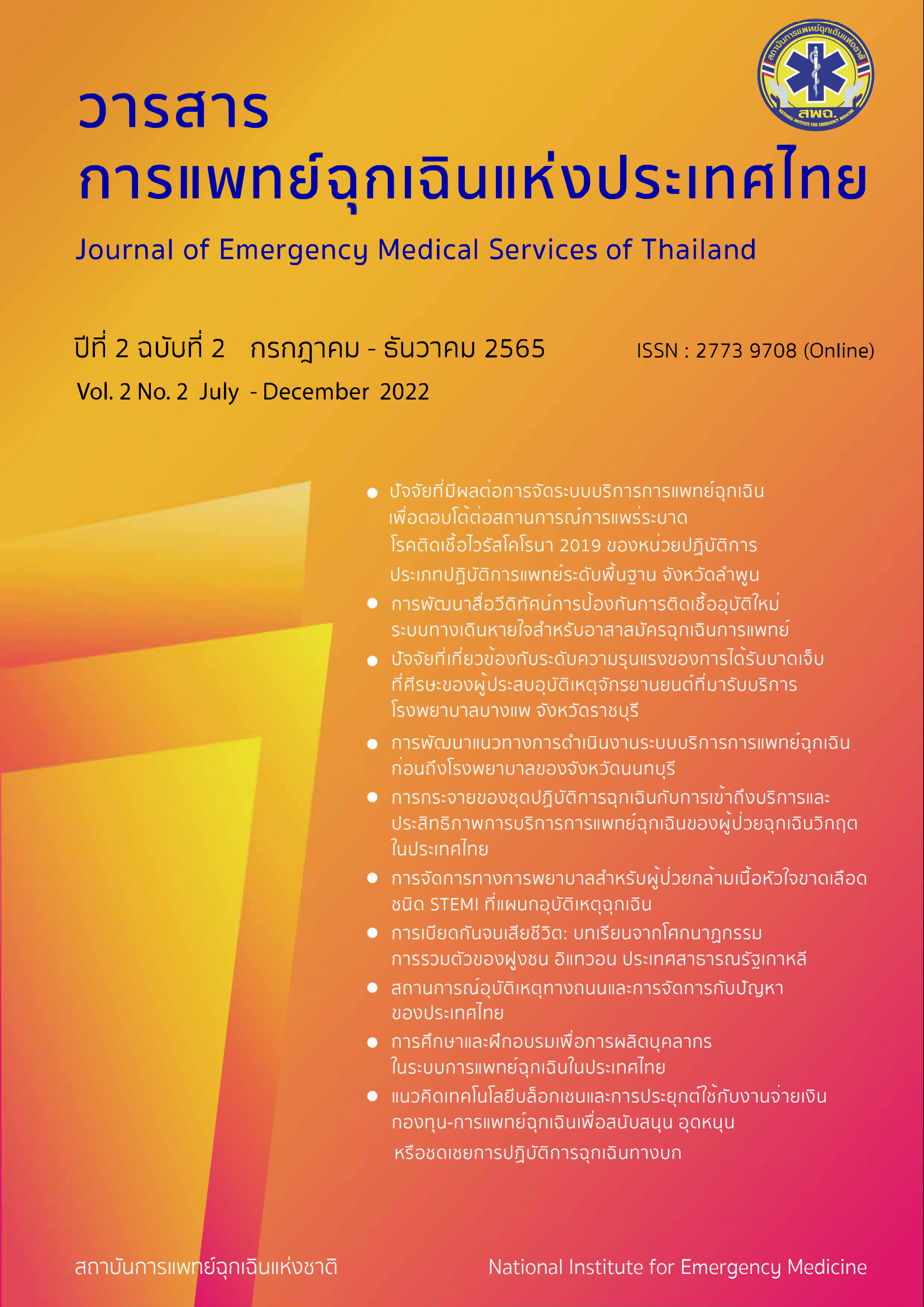การพัฒนาสื่อวีดิทัศน์การป้องกันการติดเชื้ออุบัติใหม่ระบบทางเดินหายใจ สำหรับผู้ปฏิบัติการฉุกเฉินเบื้องต้น
DOI:
https://doi.org/10.14456/jemst.2022.12คำสำคัญ:
การพัฒนา, สื่อวีดิทัศน์, การป้องกันการติดเชื้อ, โรคอุบัติใหม่ระบบทางเดินหายใจ, อาสาสมัครฉุกเฉินการแพทย์บทคัดย่อ
อาสาสมัครฉุกเฉินการแพทย์มีความเสี่ยงต่อการติดเชื้อขณะปฏิบัติงาน การพัฒนาสื่อวีดิทัศน์การป้องกันการติดเชื้ออุบัติใหม่ ระบบทางเดินหายใจสำหรับอาสาสมัครฉุกเฉินการแพทย์ มีวัตถุประสงค์เพื่อพัฒนาและประเมินประสิทธิภาพของสื่อวีดิทัศน์ กลุ่มตัวอย่างที่ศึกษา คืออาสาสมัครฉุกเฉินการแพทย์ที่ปฏิบัติงานในพื้นที่ 5 อำเภอในจังหวัดเชียงใหม่ จำนวน 47 คน เครื่องมือที่ใช้ในการวิจัยประกอบด้วย บทดำเนินเรื่องการป้องกันการติดเชื้ออุบัติใหม่ระบบทางเดินหายใจสำหรับอาสาสมัครฉุกเฉินการแพทย์ แบบสอบถามความรู้การป้องกันการติดเชื้อระบบทางเดินหายใจและแบบสอบถามความพึงพอใจที่มีต่อ สื่อวีดิทัศน์ วิเคราะห์ข้อมูลโดยใช้สถิติเชิงพรรณนาและการทดสอบค่าที่สื่อวีดิทัศน์ที่พัฒนาขึ้นประกอบด้วยเนื้อหา 3 ชุด มีความยาวรวม 29 นาที 46 วินาที ชุดที่ 1 การป้องกันการติดเชื้ออุบัติใหม่ระบบทางเดินหายใจก่อนปฏิบัติงาน ชุดที่ 2 และชุดที่ 3 เป็นการป้องกันการติดเชื้อขณะปฏิบัติงานและหลังปฏิบัติงาน ตามลำดับ ประสิทธิภาพของสื่อวีดิทัศน์มีค่า E1/E2 เท่ากับ 80.09/85.91 เป็นไปตามเกณฑ์ที่กำหนด ผลการประเมินความรู้ของกลุ่มตัวอย่างพบว่า ค่าเฉลี่ยคะแนนความรู้การป้องกัน การติดเชื้อระบบทางเดินหายใจของกลุ่มตัวอย่างหลังชมสื่อวีดิทัศน์สูงกว่าก่อนชมสื่อวีดิทัศน์อย่างมีนัยสำคัญทางสถิติ (p<0.0001) กลุ่มตัวอย่างมีความพึงพอใจต่อสื่อวีดิทัศน์ในภาพรวม ด้านเนื้อหา การลำดับเรื่องและการออกแบบ ความเหมาะสมของสื่อ การได้รับความรู้และประโยชน์ที่ได้รับจากสื่อวีดิทัศน์ในระดับมากที่สุดทุกด้าน ผลการศึกษาแสดงให้เห็นว่าสื่อวีดิทัศน์ที่พัฒนาขึ้นสามารถนำไปใช้ในการให้ความรู้แก่อาสาสมัครฉุกเฉินการแพทย์เพื่อให้สามารถปฏิบัติในการป้องกันการติด เชื้ออุบัติใหม่ระบบทางเดินหายใจได้อย่างถูกต้อง
เอกสารอ้างอิง
Montague BT, Wipperman MF, Hooper AT, Hamon SC, row R, Elemo F, et al. Anti-SARS-CoV-2 IgA identifies asymptomatic infection in first responders. J Infect Dis 2022;225(4):578-86.
Tarabichi Y, Watts B, Collins T, Margolius D, Avery A, Gunzler D, et al. SARS-CoV-2 infection among serially tested emergency medical services workers. Prehosp Emerg Care 2021;25(1):39-45.
Ellingson KD, Gerald JK, Sun X, Hollister J, Lutrick K, Parker J, et al. Incidence of SARS-CoV-2 infection among health care personnel, first responders, and other essential workers during a pre-vaccination COVID-19 surge in Arizona. JAMA Health Forum 2021;2(10):1-10.
Niu J, Rodriguez JA, Sareli C, Goldman J, Puga M, Eckardt PA. COVID-19 infection among first responders in Broward County, Florida, March - April 2020. J Public Health 2021;43(3):450-4.
Vatan A, Güçlü E, Öğütlü A, Kibar FA, Karabay O. Knowledge and attitudes towards COVID-19 among emergency medical service workers. Rev Assoc Med Bras 2020;66(11):1553-9.
Feldman M, Krylova VL, Farrow P, Donovan L, Zandamela E, Rebelo J, et al. Community health worker knowledge, attitudes, and practices towards COVID-19: Learnings from an online cross-sectional survey using a digital health platform, UpSCALE, in Mozambique. PLoS One [Internet]. 2021 [cited 2022 Sep 15];16(2): e0244924. Available from: https://doi.org/10.1371/journal.pone.0244924
Centers for Disease Control and Prevention. Guideline for isolation precautions: preventing transmission of infectious agents in healthcare settings [Internet]. 2007 [cited 2022 Sep 15]. Available from: https://www.cdc.gov/infectioncontrol/pdf/guidelines/isolation-guidelines-H.pdf
World Health Organization. Infection prevention and control during health care when coronavirus disease (COVID-19) is suspected or confirmed: interim guidance [Internet]. 2021 [cited 2022 Sep 15]. Available from: https://apps.who.int/iris/bitstream/handle/10665/342620/WHO-2019-nCoV-IPC2021.1-eng.pdf?sequence=1&isAllowed=y
World Health Organization. World Health Organization guidelines on hand hygiene in health care [Internet]. 2009 [cited 2022 Sep 15]. Available from: https://www.who.int/publications/i/item/9789241597906
Pan American Health Organization. COVID-19 Recommendations: Prehospital Emergency Medical Services (EMS) (draft document, version 4.4) [Internet]. 2020 [cited 2022 Sep 15]. Available from https://iris.paho.org/bitstream/handle/10665.2/52137/PAHOPHEIHMCOVID-19200014_eng.pdf?sequence=1&isAllowed=y
Centers for Disease Control and Prevention. Interim infection prevention and control recommendations for healthcare personnel during the Coronavirus disease 2019 (COVID-19) pandemic [Internet]. 2022 [cited 2022 Sep 15]. Available from: https://www.cdc.gov/coronavirus/2019-ncov/hcp/infection-control-recommendations.html
Araújo AF, Pereira ER, Duarte SCM, Broca PV. Pre-hospital assistance by ambulance in the context of coronavirus infections. Rev Bras Enferm [Internet]. 2021 [cited 2022 Sep 15];74(Suppl 1):1-5. Available from: http://dx.doi.org/10.1590/0034-7167-2020-0657e20200657
Federal Healthcare Resilience Working Group EMS/Prehospital Team. NHTSA Office of EMS. Guidance for Preventing Disease Spread During Transport with Populations at High Risk for COVID-19 illness [Internet] 2020 [cited 2022 Sep 15]. Available from: https://www.ems.gov/pdf/Federal_Guidance_and_Resources/Operations/Guidance_Preventing_Disease_Spread_During_COVID-19_Patient_Transport.pdf
National Association of EMS Physicians. Ambulance specific considerations [Internet]. 2020 [cited 2022 Sep 15]. Available from: https://naemsp.org/NAEMSP/media/COVID-19-Sample-Protocols/Ambulance-Specific-Considerations-Encl-4-(FINAL).pdf
Illinois Department of Public Health. CDC’s Interim guidance for emergency medical services (EMS) systems and 911 public safety answering points (PSAPs) for COVID-19 in the United States [Internet]. 2020 [cited 2022 Sep 15]. Available from: https://www2.illinois.gov/sites/sfm/CurrentFocus/Documents/20200310_Updated_EMS_First_Response_.pdf
Alessi SM, Trollip SR. Computer based instruction: methods and development. Upper Saddle River, NJ: Prentice Hall, 1991.
ชัยยงค์ พรหมวงศ์. การทดสอบประสิทธิภาพสื่อหรือชุดการสอน. วารสารศิลปากรศึกษาศาสตร์และวิจัย [อินเทอร์เน็ต] 2556 [สืบค้นเมื่อ 15 ก.ย. 2565];5(1):1-20. แหล่งข้อมูล: http://www4.educ.su.ac.th/2013/images/stories/081957-02.pdf
อะเคื้อ อุณหเลขกะ. รายงานการพัฒนาสื่อ social media การป้องกันการติดเชื้อจากการปฏิบัติงานสำหรับอาสาสมัครฉุกเฉินการแพทย์. เชียงใหม่: คณะพยาบาลศาสตร์ มหาวิทยาลัยเชียงใหม่; 2559.
Potter PA, Perry AG. Basic nursing: essentials for practice. 6th ed. St. Louis: Mosby; 2007.
ณัฐนันท์ เกตุภาค, วิลาวัณย์ พิเชียรเสถียร, อารีวรรณ กลั่นกลิ่น. ผลของการให้ข้อมูลโดยใช้สื่อวีดิทัศน์ต่อความรู้และการปฏิบัติของผู้ป่วยในการป้องกันการติดเชื้อในโรงพยาบาล. วารสารพยาบาล 2554;38(3):98-109.
ดาวน์โหลด
เผยแพร่แล้ว
รูปแบบการอ้างอิง
ฉบับ
ประเภทบทความ
สัญญาอนุญาต
ลิขสิทธิ์ (c) 2022 วารสารการแพทย์ฉุกเฉินแห่งประเทศไทย

อนุญาตภายใต้เงื่อนไข Creative Commons Attribution-NonCommercial-NoDerivatives 4.0 International License.






